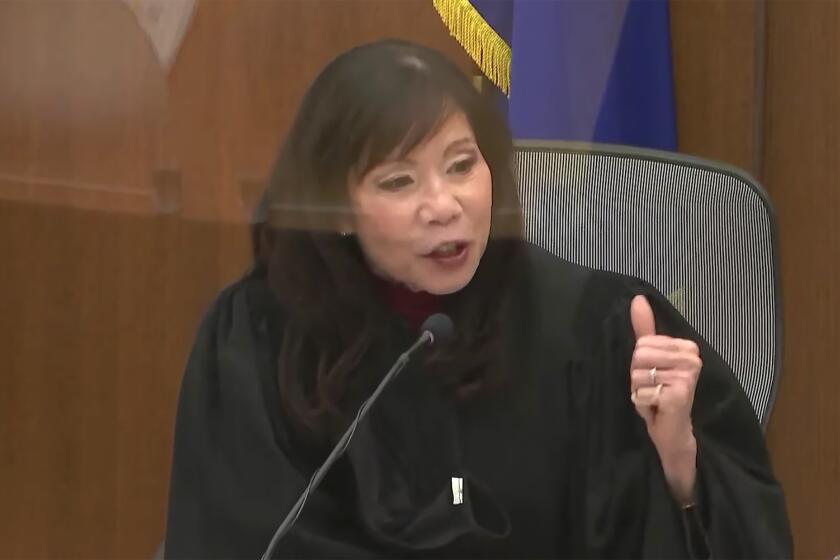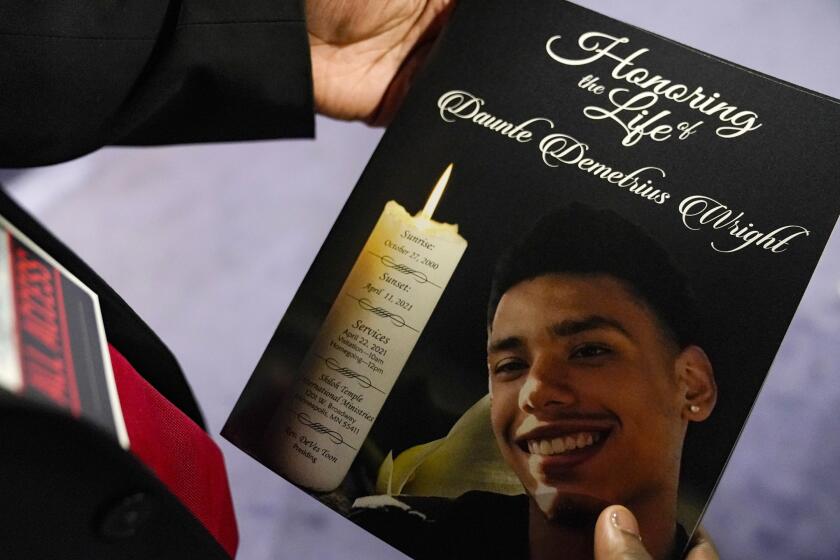Shadow of Floyd, Chauvin case hangs over trial of officer who shot Daunte Wright

MINNEAPOLIS — It’s former Officer Kim Potter who’s on trial for the killing of Daunte Wright, but the trial in the same courtroom earlier this year of ex-cop Derek Chauvin in the death of George Floyd is casting a shadow over the proceedings.
During jury selection last week, there was little mention of Chauvin or Floyd, whose death at Chauvin’s hands in Minneapolis in May 2020 sparked outrage over police brutality in the U.S. The court has seemed determined at times not to bring it up.
But with opening statements in Potter’s trial set for Wednesday, reminders of the earlier case are everywhere, including the presence of some of the same prosecutors who tried Chauvin as well as potential jurors being asked about their fears of delivering an unpopular verdict.
Hennepin County Judge Regina Chu is using the same 18th-floor courtroom where Chauvin, who is white, was convicted of murder in April by a jury who repeatedly watched video of him kneeling on the neck of Floyd, a Black man. It’s also where Chauvin was later sentenced by Judge Peter Cahill to 22.5 years in prison.
Video will also figure prominently in Potter’s manslaughter trial. The jury will see video showing Potter, who is white, shouting, “Taser, Taser, Taser!” as she aimed her Glock 9 mm semi-automatic pistol at Wright, a Black man, as he tried to drive away from a traffic stop April 11. Potter then fired a fatal bullet into Wright’s chest before exclaiming: “I grabbed the wrong ... gun!”
Potter’s attorneys say Wright’s death was an innocent mistake, not a crime.
An attorney for the suburban Minneapolis police officer who shot and killed Daunte Wright says the former officer will testify at her trial.
Though Floyd’s death was rarely mentioned directly during jury selection, his case’s effect on the trial has been obvious. The jury pool received nearly the same questionnaires used for Chauvin’s trial, with only slight edits in some places to fit the circumstances of the Potter case. It doesn’t mention either Chauvin or Floyd by name.
Jurors were asked whether they agreed with the “defund the police” movement that gained momentum after Floyd’s death. They were asked whether they trust police — and whether it’s right to second-guess an officer’s actions under pressure. They were also asked if they had been affected by damaging protests.
Prosecutors and the defense sifted their answers carefully and probed deeper in court. People with moderate views were more likely to be seated, including a man who said he opposed cutting police funding but who also said: “I absolutely believe there’s a need for change.”
Some potential jurors were asked by the defense if they had any concern about blowback if they were to acquit Potter. The only Black person to make it onto the jury, a woman in her 30s, said that “is not a concern for me.”
Former police officer Kim Potter is standing trial in Minnesota on manslaughter charges in the fatal shooting of Daunte Wright.
One of the few direct mentions of Floyd came from a woman who said that his case “caused a lot of trauma in our city” and that it made her sad. She said she did not like the negative attention it brought Minneapolis, but said a positive result of protests was that important issues were being discussed.
She made the jury as an alternate.
As with Chauvin’s, Potter’s trial is being livestreamed, a rarity in Minnesota that is partly a concession to high public interest and partly due to pandemic considerations. The courtroom has clear plastic dividers that are strategically placed.
People who tune in will see some of the same faces of those who successfully prosecuted Chauvin: Matthew Frank and Erin Eldridge, both Minnesota assistant attorneys general, sit at the prosecution table, with their boss, Keith Ellison, frequently in the courtroom.
Security is heightened for the trial, with several entrances to the courthouse closed off. But the tall chain-link fences, razor wire and concrete barriers put in place for Chauvin are gone, as are the National Guard soldiers and armored vehicles that patrolled the area last spring. And the building is open to the public.
More to Read
Sign up for Essential California
The most important California stories and recommendations in your inbox every morning.
You may occasionally receive promotional content from the Los Angeles Times.












